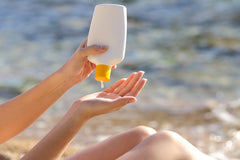Dx Beach Feet: 4 Ways to Heal Your Summer Heels

Summertime fun means sporting sandals or- in many cases- going barefoot, that exposes your feet to the harsh elements of the season. Check out these 4 tips that are just what the doctor ordered to heal your summer heels!
Wash
It’s just not enough to let the water and suds trickle down to your feet when showering and claim that they are clean. A barefoot day at the beach or a simple saunter in your favorite flip-flops can expose your feet to all sorts of yuck-n-muck. The solution? Take care to give your feet a thorough washing DAILY (that means rubbin’ and scrubbin’). Foot washing is like hand washing and should be done routinely. It is also a great idea to soak your feet with warm water and Epsom salt. Soaking your feet provides a one-two punch of deodorizing and drawing out toxins to keep them funk-free!
Inspect
Bacteria, Virus, and Fungus….oh my! Your feet can become infected with any of these “beauties” with any cuts or openings of the skin. Whether you have the displeasure of stepping on rocks, shells, or any foreign object openings of the skin can be dangerous- large and small. That’s why it is essential to regularly inspect your feet for any open wounds or lesions that may be present. Warts can indicate viruses (such as HPV), while redness, swelling, and/or itching can be signs of bacterial (E. coli) or fungal (Athlete’s foot) infections.
Exfoliate
Unforgiving surfaces such as hot sand and pavement can lead to a load of calluses on the feet. To transition your feet from rough to smooth, exfoliate the callused areas. Be careful to ALWAYS exfoliate WET skin- preferably when showering or soaking. Tools, such as pumice stones or foot files are most aggressive, but scrubs can also do the trick.
Moisturize
Once you remove the skin you don’t want, you always want to show a lil love to the skin you do want. And nothing says T-L-C like a rich moisturizer. A daily slather of moisturizer to clean feet smoothes the skin and provides nutrients to make your feet very supple. It’s the perfect finish to healing those summer heels!
Oh!...and as always, if you’re going to continue to be out in the sun… DON’T forget the sunscreen!!
Putting your best FEET forward,
SH
Safety's Only Skin Deep

Looks like beauty isn’t the only thing that is skin deep. Check out these 3 common types of skin cancer that can turn YOUR summer into an absolute bummer.
Basal Cell Carcinoma
What is it: The most common form of skin cancer that spreads slowly. Appears as a smooth shiny nodule on the skin.
Who is most likely affected: Individuals with a fair skin complexion are most at risk.
Where does it strike: The face is most common, but can be found on any area of the body subject to long term sun damage
When does it occur: Adults over 40 are most commonly diagnosed.
Squamous Cell Carcinoma
What is it: Aggressive form of skin cancer that begins as a scaly red inflamed nodule that develops into an ulcer. Early diagnosis is key because it spreads very quickly.
Who is most likely affected: Fair skinned individuals beware! But anyone who has been subject to prolonged sun exposure should listen up. Smoking can also be a cause.
Where does it strike: The face and back of the hands are the problem areas for men, while the legs and feet are most common for women.
When does it occur: Adults 55 years or older.
Melanoma
What is it: The most deadly- but least common- form of skin cancer. Usually forms from a pre-existing mole or pigmented lesion that is asymmetrical and deformed. Spreads rapidly.
Who is most likely affected: People with light skin complexions are most at risk, especially those with freckles, red hair, or those who burn easily. However as much as 10% of those affected are of dark complexion.
Where does it strike: Areas most exposed to the sun (noticing a theme here?). The face is a common area for men and the legs for women. The soles of the hands and feet and the nails are most often affected by those with darker skin.
When does it occur: Usually found in those that are 50+, but can occur as early as 30 years of age.
As always, monitor the amount of time that you spend in the sun. If you are going to be exposed to the sun for extended periods of time always apply (and RE-apply) your sunscreen when needed. Inspect your skin regularly, and if you note any changes or formations of skin lesions report to your physician immediately. Early diagnosis is key!
Putting your best FEET forward,
SH
5 Areas You Don’t Want to Forget to Apply Sunscreen

So you think you’ve slathered on your sunscreen and are ready for a day of fun in the sun…but have you considered these areas? You better!
From HEAD…
Scalp: 
Whether you’re bald or have long luscious locks, an exposed scalp should not be taken lightly for sun protection. Even the smallest part in your (hair)do can reveal enough skin for the sun to do damage. Studies show that melanoma on the scalp can result in a faster rate of death than any other part of the body.
Ears: 
Arms, legs, and face…CHECK! But did you get your ears? They are the 3rd most common site for skin cancer from the sun and should NEVER go untouched. If sunscreen for your ears doesn’t tickle your fancy, try a nice hat with a wide brim to shield you from the sun.
Lips: 
Did you miss a spot with your sunscreen, but can’t figure out where? It could be right under your nose- literally! That’s right the thinner skin and lack of melanin in your lips make them especially vulnerable to the damage from harmful sun rays. It’s best to use lip balm with SPF to keep your kisser in good condition!
Hands: 
They assist you in applying sunscreen to every other part of your body but it’s easy to forget they need a little help being protected from the sun. The palms may be slathered with sunscreen, but don’t forget the back of your hands.
To TOE…
Feet: 
Going barefoot or wearing sandals means your feet are largely uncovered. That makes your feet very susceptible to sun’s harmful rays. Take care to apply sunscreen to the tops & soles of the feet. Don’t forget between the toes! It is a common hideout spot for melanoma of the feet that should NEVER go unnoticed! Don’t forget the nails!
Putting your best FEET forward,
SH
Sandal Season Survival Series TIP #3: What Lies Beneath

No sandal season is officially underway without finding and sporting the perfect shade of nail polish. But as you polish those lil’ piggies, you may be surprised to know that it's highly recommended that you routinely inspect your nails WITHOUT polish for any lurking signs of skin cancer. We know this may sound like awful news for your summer-ready-pedi but skin cancer can rear its ugly head right under your pretty polished nails. What should you look for? The most notable change can be indicative of malignant melanoma, where a linear mark of increased pigmentation- Hutchinson’s sign- forms on the nail bed (skin underneath the nail). It is also a good idea to examine your cuticles for warts or lesions and the nail itself for any deformities. Every 1-3 months is a suggested time to give your nails a look-see (or sooner depending on your level of sun exposure or prior history of skin cancer). There are brands of nail polish that make the claim of providing UV protection against skin cancer, but it is still recommended that you remove your nail polish periodically to inspect your nails for any possible changes. You cannot check your nails enough and always remember: EARLY DETECTION IS KEY!!
Putting your best FEET forward,
SH
Sandal Season Survival Series TIP #2: Pssst! Your Epidermis Is Showing

Wanna REALLY get sandal season into full swing?...Then sunscreen is an absolute must-have to keep in your arsenal to survive the summer safely. The face, back, arms and legs are all the craze when it comes to applying sunscreen, but it’s also a very good idea to slather the tootsies to protect them from the harmful sun rays. To protect your feet from the sun:
• Apply sunscreen with a minimum Sun Protection Factor (SPF) of 30. You want to lookout for sunscreens that are labeled “water-resistant” and “broad spectrum” that hold up against water exposure and protect you from both UVB (contributes to melanoma) and UVA (causes skin damage) rays.
• Sunscreen should be applied at least 30 minutes prior to going outdoors. It takes approximately 15 minutes for your skin to fully absorb the sunscreen you apply. If you wait until you are outside to apply, you run the harmful risk of your skin becoming scorched by the sun.
• Make sure ALL exposed skin is protected. Wearing sandals means your feet are largely uncovered. That makes your feet very susceptible to sun’s harmful rays. Take care to apply sunscreen to the tops & soles of the feet. Don’t forget between the toes! It is a common hideout spot for melanoma of the feet that should NEVER go unnoticed! With creams you always want to be careful when applying between the toes however. Do not place too much cream in between the toes to prevent any macerations (breakdown) of the skin.
• Reapply! Just because you applied sunscreen before going outdoors does not mean you’re fully protected. You should always reapply sunscreen every 1-2 hours while frolicking in the sun. Certain factors such as water exposure, excessive sweating, and individuals with reduced skin pigmentation may require more frequent reapplications.
No matter if it’s the summertime or any other time of the year, ALWAYS inspect your skin for any potential changes, paying very close attention to any moles or lesions that may be present. If you suspect any changes in your skin, report to your physician immediately!
Tip #3 on the way…
Putting your best FEET forward,
SH
Pamper Scamper

Looking for the right salon to get those tootsies touched up for sandal season? Here are 9 rules we found that we think you should know....courtesy of elle.com!
Putting your best FEET forward,
SH
Not So Fun In The Sun

According to the American Cancer Society, skin cancer is the most common cancer found in the United States, with melanoma being the most dangerous form. But in your pursuit of having fun in the sun this summer, do you know what changes to spot to make sure your skin remains safe from head to toe? Check out these common signs of melanoma from A to Z....err E!
Asymmetry: Moles that are uniform in shape should give little cause for concern. However, a mole where one half is different from the other half could indicate melanoma.
Borders: Moles should have borders that are smooth and consistent. A lesion may be cancerous if you notice its borders being jagged and irregular.
Color: Always look for moles to be one solid color (typically brown or tan). Moles that are multi-colored or speckled are likely melanoma.
Diameter: Moles that are less than 6mm (1/4in)- the width of a pencil eraser- are usually harmless. However if they exceed 6mm, then you should suspect melanoma.
Elevation: Inspect if a lesion is flat or elevated. Lesions that are raised above the surface of the skin often appear in the occurrence of melanoma.
What the FOOT!?!: Have you heard of Hutchinson’s Sign? It is a linear mark of increased pigmentation indicating melanoma under the nail. It begins at the base of the nail and extends towards the tip of the nail. It is always a good to remove nail polish and examine nails to note any potential changes under your nails.

Other places to note melanoma of the foot: top of the foot, sole, and in between the toes.
If you suspect any changes in moles or lesions to your skin, report to your physician immediately! And remember, early detection is ALWAYS key, with any form of cancer. The sooner it can be diagnosed, the far better chance you have of recovery.
Putting your best FEET forward,
SH
Nail Salons? You Better Think Twice!
We here at Southern Hospitality recommend that you take a personal natural approach to show your puppies some love. Check out this video from ABC’s 20/20 and see why putting your feet in the wrong hands can spell danger for your dogs! Well, guess what they say is true.......if you want something done right, you just may have to do it yourself!
Putting you best FEET forward,
SH
Frost BITES!

FOOT FACT:
9 out of 10 cases of frostbite in adults occur in the hands & feet (feet being the most common). Prolonged exposure to frigid temperatures can halt blood flow to your extremities, depriving them of oxygen, leading to nerve and tissue damage. Warning signs include: numbness, red to bluish-grey discoloration of the affected area, and “waxy” skin appearance. Skin that is not properly protected from subzero temperatures and intense windchills can fall victim to frostbite in just 10 minutes! It is a good idea to always bundle up with the proper attire to protect yourself before battling the elements. And remember…NO COTTON SOCKS!!
Putting you best FEET forward,
SH
Feel the Burn

FOOT FACT:
You may be thinking to yourself that pain is pain….right?...wrong!
A burning pain in the legs & feet could signal nerve damage (neuropathy). Damaged nerves send constant misfired signals to your brain triggering burning sensations of pain. Diabetes is the most common culprit… but alcoholism, Vitamin B12 deficiency and heavy metal poisoning are some other causes that can hold your feet to the fire.
Putting you best FEET forward,
SH




